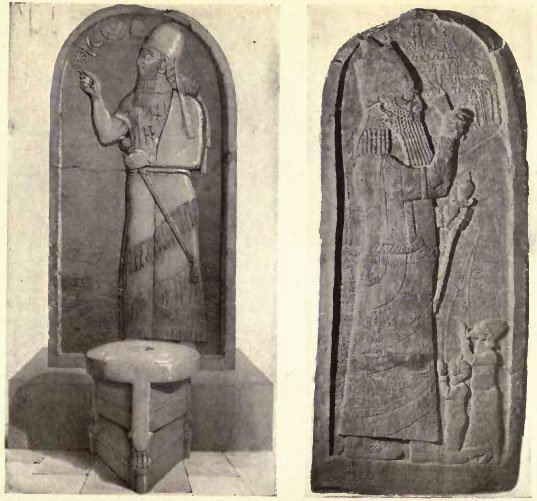The civilization of Babylonia and Assyria
Its remains, language, history, religion, commerce, law, art, and literature
by Morris Jastrow | 1915 | 168,585 words
This work attempts to present a study of the unprecedented civilizations that flourished in the Tigris-Euphrates Valley many thousands of years ago. Spreading northward into present-day Turkey and Iran, the land known by the Greeks as Mesopotamia flourished until just before the Christian era....
Part XVIII
Like Tiglathpileser IV, Sargon probably rose from the ranks, but he could hardly have attained his position without some violence which, perhaps, he deemed it wiser to pass over in silence in his annals. In many respects the campaigns of Sargon are repetitions of the conditions prevailing in the days of Tiglathpileser.
In Babylonia we find the "sea land" organizing an attempt to place a native once more on the throne, Marduk-paliddin, who starts out as a local chief by ingratiating himself with Tiglathpileser IV, but as he grows in power takes advantage of the change of dynasty to make himself master of all Babylonia in the very same year that Sargon begins his rule.
A first and immediate attempt to suppress Mardukpaliddin failed, and for the next years Sargon was so much occupied with campaigns against the Hittite state of which Carchemish was the capital, against the petty kingdoms of northern Syria and in the regions to the northeast that it was not until the year 710 B.C. that he succeeded in putting Marduk-paliddin out of the way, and in himself again assuming as king of Assyria the direct rule over the south as well.
Sargon sets up the claim of being the deliverer of Babylonia and inaugurates a policy marked by great consideration for the ancient rights of the populace. The policy, however, was of little avail. Babylonia continued to chafe under the humiliation of a northern rule imposed upon her.
The large centres were hotbeds of intrigue and opposition to Assyria. Uprisings beginning usually in the extreme south and fomented by Elam, which had hopes of again conquering her old enemy, followed in frequent succession until finally in the days of Sennacherib, the son of Sargon, the patience of Assyria was exhausted, and in 689 B.C. Sennacherib marched against Babylon and destroyed the ancient city entirely.
The reigns of Sargon (721-705 B.C.) and of his son Sennacherib (705-681 B.C.) thus mark further steps leading inevitably to the dissolution of the Babylonian kingdom after an existence of about two millenniums. The other new factor was the approaching conflict between Assyria and Egypt.
Foreshadowed in the days of Sargon, the direct encounter between the two mighty powers took place in 701 B.C., through the assistance given by Egypt to an uprising of Syria, the Phoenician coast and Palestine against the Assyrian yoke. The Egyptians were defeated, the uprising broken up, but owing to disturbed conditions in Babylonia, Sennacherib was unable to follow up the advantage gained by him and hastened back to put things in order nearer home.
It is surprising that Assyria was able to bear the strain of these campaigns, organized on a larger scale than before, for the entire century intervening between Tiglathpileser IV and the destruction of Nineveh in 606 B.C. The stretch of her dominions passed beyond the borders of the Mediterranean. Under the greatest possible difficulties a fleet was added to the equipment, and Cyprus incorporated as a part of the Assyrian power.
Sennacherib fell a victim in 680 B.C., to the blow of an assassin, who was his own son or according to the Biblical account, [1] there were two sons involved. His son Esarhaddon, appointed by Sennacherib as the heir to the throne, succeeded in quelling the uprising and in establishing himself firmly.
Eeverting to the policy of his grandfather, Sargon, he decided to make an endeavor to reconcile the Babylonians by rebuilding the city of Babylon. Despite this, the "sea land" continued to be a centre of opposition and Esarhaddon passed through the same experiences as his predecessors.
Esarhaddon took the bold step of crossing over into Egypt. The victorious standard of Assyria was planted on the Nile, and in 670 B.C. /the ancient capital Memphis fell into the hands of the Assyrian king. The ruling dynasty was overthrown, the government of the country reorganized under Assyrian control, though as a concession to tradition a native was recognized or set up by him as king of the twenty-two provinces or nomes into which Egypt was divided.
In addition to Egypt, portions of northern and southern Arabia which had hitherto stood in a very loose connection with Assyria were brought under a firmer control, though it could hardly be said that the enormous tracts of central Arabia, so difficult of access and in which hordes of Bedouin tribes roamed at will, were ever really subject to Assyria.

Fig. 1 (left), King Ashurnasirpal III of Assyria (883-859 B.C.)
Fig. 2 (right), King Esarhaddon of Assyria (680-669 B.C.) with two royal prisoners
Footnotes and references:
[1]:
II Kings 19, 36-37.
